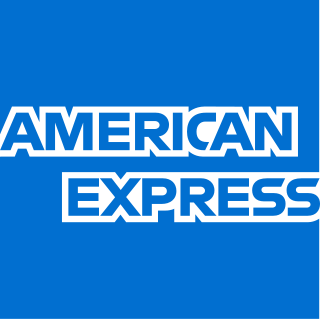EF Hutton was an American stock brokerage firm founded in 1904 by Edward Francis Hutton and his brother, Franklyn Laws Hutton. Later, it was led by well known Wall Street trader Gerald M. Loeb. Under their leadership, EF Hutton became one of the most respected financial firms in the United States and for several decades was the second largest brokerage firm in the country.

The American Express Company or Amex is an American bank holding company and multinational financial services corporation that specializes in payment cards. It is headquartered at 200 Vesey Street, also known as American Express Tower, in the Battery Park City neighborhood of Lower Manhattan. Amex is the fourth-largest card network globally based on purchase volume, behind China UnionPay, Visa, and Mastercard. 141.2 million Amex cards were in force worldwide as of December 31, 2023, with an average annual spend per card member of US$24,059. That year, Amex handled over $1.7 trillion in purchase volume on its network. Amex is one of the largest US banks, and is ranked 77th on the Fortune 500 and 28th on the list of the most valuable brands by Forbes. In 2023, it was ranked 63rd in the Forbes Global 2000. Amex also owns a direct bank.

Sanford I. "Sandy" Weill is an American banker, financier, and philanthropist. He is a former chief executive and chairman of Citigroup. He served in those positions from 1998 until October 1, 2003, and April 18, 2006, respectively.
Morgan Stanley Wealth Management is an American multinational financial services corporation specializing in retail brokerage. It is the wealth & asset management division of Morgan Stanley. On January 13, 2009, Morgan Stanley and Citigroup announced that Citigroup would sell 51% of Smith Barney to Morgan Stanley, creating Morgan Stanley Smith Barney, which was formerly a division of Citi Global Wealth Management. The combined brokerage house has 17,646 financial advisors and manages $2 trillion in client assets. Clients range from individual investors to small- and mid-sized businesses, as well as large corporations, non-profit organizations and family foundations.
Kuhn, Loeb & Co. was an American multinational investment bank founded in 1867 by Abraham Kuhn and his brother-in-law Solomon Loeb. Headed from 1885 onwards by Jacob H. Schiff, Loeb's son-in-law, it grew to be one of the most influential investment banks in the late-19th and early-20th centuries, financing America's expanding railways and growth companies, including Western Union and Westinghouse, and thereby becoming the principal rival of J.P. Morgan & Co.
Dean Witter Reynolds was an American stock brokerage and securities firm catering to a variety of clients. Prior to the company's acquisition, it was among the largest firms in the securities industry with over 9,000 account executives and was among the largest members of the New York Stock Exchange. The company served over 3.2 million clients primarily in the U.S. Dean Witter provided debt and equity underwriting and brokerage as mutual funds and other saving and investment products for individual investors. The company's asset management arm, Dean Witter InterCapital, with total assets of $90.0 billion prior to the acquisition, was one of the largest asset management operations in the U.S.
PaineWebber & Co. was an American investment bank and stock brokerage firm that was acquired by the Swiss bank UBS in 2000. The company was founded in 1880 in Boston, Massachusetts, by William A. Paine and Wallace G. Webber. Operating with two employees, they leased premises at 48 Congress Street in May 1881. The company was renamed Paine, Webber & Co. when Charles Hamilton Paine became a partner. Members of the Boston Stock Exchange, in 1890 the company acquired a seat on the New York Stock Exchange. Wallace G. Webber retired after the business weathered a major financial crisis of 1893.
Jansen Noyes Jr. (1918–2004) was an investment banker and stock brokerage company executive.
Hayden, Stone & Co. was a major American securities firm founded in 1892 by Charles Hayden and Galen L. Stone. The firm was acquired by Cogan, Berlind, Weill & Levitt in 1972 and, after its name disappeared in 1979, was part of what would become Shearson/American Express in 1981.
H. J. Meyers & Co was an American investment banking and brokerage firm that specialized in small cap and micro cap financings. Its headquarters were in Rochester, New York but it had a large Southern California presence. It was originally known as Thomas James Associates, Inc before they acquired H.J. Meyers & Co, Inc. The firm had a reputation of being a boiler room that operated within the realm of unscrupulous policies, stock manipulation, fraudulent, high pressure sales tactics and excessive markups were common.
L.F. Rothschild was a merchant and investment banking firm based in the United States and founded in 1899. The firm collapsed following the 1987 stock market crash.

Shearson was the name of a series of investment banking and retail brokerage firms from 1902 until 1994, named for Edward Shearson and the firm he founded, Shearson Hammill & Co. Among Shearson's most notable incarnations were Shearson / American Express, Shearson Lehman / American Express, Shearson Lehman Brothers, Shearson Lehman Hutton and finally Smith Barney Shearson.

Shearson, Hammill & Co. was a Wall Street brokerage and investment banking firm founded in 1902 by Edward Shearson and Caleb Wild Hammill. The firm originally built its business as a stock broker as well as a broker of various commodities, particularly grain and cotton. The firm was a member of the New York Stock Exchange, the Chicago Stock Exchange and the Chicago Mercantile Exchange.
Loeb, Rhoades & Co. was a Wall Street brokerage firm founded in 1931 and acquired in 1979 by Sanford I. Weill's Shearson Hayden Stone. Although the firm would operate as Shearson Loeb Rhoades for two years, the firm would ultimately be acquired in 1981 by American Express to form Shearson/American Express and three years later Shearson Lehman/American Express.
Cogan, Berlind, Weill & Levitt, originally Carter, Berlind, Potoma & Weill, was an American investment banking and brokerage firm founded in 1960 and acquired by American Express in 1981. In its two decades as an independent firm, Cogan, Berlind, Weill & Levitt served as a vehicle for the rollup of more than a dozen brokerage and securities firms led by Sanford I. Weill that culminated in the formation of Shearson Loeb Rhoades.
Peter A. Cohen is the chairman and CEO of Andover National Corporation, a public holding company. He was formerly the chairman and CEO of Cowen Inc., also known as Cowen & Company now TD Cowen. Prior to his current role, Cohen founded Ramius Capital Management in 1994, a $13 billion investment firm, which he merged with Cowen Inc. in 2009. Prior to this, Cohen was the chairman and chief executive officer of Shearson Lehman American Express from 1983 through 1991.

Dain Rauscher Wessels was a brokerage and investment banking firm based in Minneapolis, Minnesota. The firm traced its origins to a number of smaller regional securities firms founded in the 1920s and 1930s.

John Langeloth Loeb Sr. was an American investor and executive who served as president of Loeb, Rhoades & Company.
Ralph Hornblower was an American business executive who was the senior partner in Hornblower & Weeks, an investment banking firm established by his father, Henry Hornblower, and John W. Weeks.








